|
|
|
Sort Order |
|
|
|
Items / Page
|
|
|
|
|
|
|
| Srl | Item |
| 1 |
ID:
160787
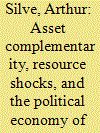

|
|
|
|
|
| Summary/Abstract |
Collaboration between two groups that may invest their resources in a common productive activity has the potential to lead to conflict over the output of that activity. This article examines the stakes of such conflict as well as the willingness for parties to subject themselves to a third-party arbiter. The model highlights three determinants of conflict and of investment in credibility-enhancing institutions: the value of the output, the relative endowments of the parties, and the mutual benefits of collaboration. In particular, the analysis shows that complementarity between the groups’ resources lowers the stakes of political conflict and increases the incentives to commit. The model thus suggests a new mechanism through which we can understand the frequency of conflict and the poor institutions associated in countries with mineral resources. The model’s predictions also help us to understand how Mauritius avoided the resource curse and was able to develop sustainable economic growth.
|
|
|
|
|
|
|
|
|
|
|
|
|
|
|
|
| 2 |
ID:
160783
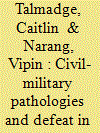

|
|
|
|
|
| Summary/Abstract |
This article uses an original data set, the Wartime Civil-military Relations Data Set, to test arguments about the causes of victory and defeat in war. Our analysis provides strong initial support for the notion that civil-military relations powerfully shape state prospects for victory and defeat. Specifically, states whose militaries have a significant internal role or whose regimes engage in coup-proofing appear to have a substantially lower probability of winning interstate wars, even when we account for the role of other important variables, including regime type and material capabilities. Crucially, our measures of civil-military relations include coup incidence but also move beyond it to detect more subtle indicators of civil-military relations. The resulting analysis should give us confidence in acknowledging the importance of nonmaterial variables in explaining war outcomes, while also paving the way for further research that can utilize and extend the data set.
|
|
|
|
|
|
|
|
|
|
|
|
|
|
|
|
| 3 |
ID:
160789
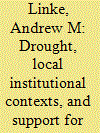

|
|
|
|
|
| Summary/Abstract |
We address two questions on the effects of climate change for social instability. First, do droughts and their associated environmental impacts affect support for the use of violence? Second, do local-level formal and informal institutions moderate support for violence when and where droughts worsen? To answer these questions, we conducted a national survey of 1,400 Kenyans in 2014. Respondents were asked about patterns of rainfall and the presence of rules regulating natural resource use and access. Survey data are joined to spatially disaggregated observed rainfall trends. The survey uses endorsement experiments to elicit honest responses about support for using violence. There is some evidence of a direct, though limited, link between observed drought and violent attitudes. Certain local-level natural resource use rules have moderating effects on support for violence where drought is reported and precipitation is less frequent. This conditional and contextual effect is an important modification of overly simplistic narratives of universal climate change effects.
|
|
|
|
|
|
|
|
|
|
|
|
|
|
|
|
| 4 |
ID:
160784


|
|
|
|
|
| Summary/Abstract |
Signals from domestic and international actors have been shown to influence the likelihood of coups. Coups remain difficult to predict and consequently leave policy makers in a reactive stance, but little systematic work assesses how these reactions influence long-term outcomes. We examine how reactions from domestic and international actors influence the duration of coup-born regimes, arguing that negative reactions will shorten leadership duration. We further probe these relationships by considering how signaling consistency, Cold War dynamics, and precoup relationships condition the influence of reactions on leadership duration. Tests use events data to capture domestic and international reactions and newly coded information on leadership to capture leader duration. Results indicate that international responses have a profound influence on leadership tenure, especially those from strong actors. We find tentative support that state reactions have the strongest effect during the Cold War, while international organizations matter the most afterward.
|
|
|
|
|
|
|
|
|
|
|
|
|
|
|
|
| 5 |
ID:
160788
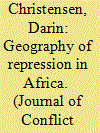

|
|
|
|
|
| Summary/Abstract |
I ask how the location of a protest affects how forcefully governments crack down. This geography of repression provides insight into a larger strategic problem: under what conditions do leaders meet protests with violence? I argue that protests in rural areas pose a smaller threat and, thus, prompt less frequent intervention. However, when governments decide to repress rural protests, they are less concerned that lethal repression might incite a backlash, as there are fewer bystanders in more rural areas that can join the fray. I uncover two patterns consistent with this theory: (1) repression is 30 percent more frequent in response to social conflicts in urban areas; but (2), if the state does employ repression, it is 75 percent more likely to kill dissidents in rural areas. The empirical relationships I report cannot be explained by reporting bias, international sanctioning, proximity to past armed conflicts, or the presence of natural resources.
|
|
|
|
|
|
|
|
|
|
|
|
|
|
|
|
| 6 |
ID:
160786
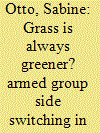

|
|
|
|
|
| Summary/Abstract |
Why do armed groups switch sides during civil wars? Most theories of conflict assume that armed groups have a fixed alignment with the government throughout their entire life span, ignoring the fact that armed groups switch between fighting on behalf of and against the government. In this article, I propose a theoretical framework that integrates armed groups’ willingness to switch sides and their capacity to do so. Armed groups are motivated to switch sides if it contributes to maintaining or improving organizational objectives. I therefore expect armed groups to switch sides as the number of other armed groups with the same alignment increases and when the state is weak. I also argue that armed groups require the capacity to switch sides in order to overcome the internal coordination problem. I propose that non-state armed actors that are the product of prior splintering are more homogeneous and cohesive than other groups. Hence, they are in a better position to attempt to switch sides. I test the propositions using a novel data set, the History of Armed Actors Dataset, containing data on when and where armed groups have switched sides during civil wars between 1989 and 2007. The results reveal that both incentives and capacity influence side switching.
|
|
|
|
|
|
|
|
|
|
|
|
|
|
|
|
| 7 |
ID:
160785
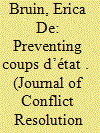

|
|
|
|
|
| Summary/Abstract |
Although coups remain a pressing concern for rulers across the globe, the mechanisms through which common coup-prevention strategies operate have not been well theorized or rigorously tested. This article analyzes how “counterbalancing” the military with other security forces prevents coups. Using new cross-national time-series data on state security forces along with evidence from sixteen case studies, the article demonstrates that counterbalancing reduces the likelihood that coup attempts will succeed and that it does so primarily by creating incentives for some soldiers to resist the coup, rather than by creating barriers to coordination between forces. However, counterbalancing is not associated with fewer coup attempts. In fact, the creation of a new security force increases the odds of a coup attempt in the following year. These findings highlight potential costs associated with counterbalancing and explain why it is not more widespread.
|
|
|
|
|
|
|
|
|
|
|
|
|
|
|
|
| 8 |
ID:
160790


|
|
|
|
|
| Summary/Abstract |
Violence is a key means used by organized crime to assert its control over territory and business. A widespread view is that violence is bound to take place also in the new territories where mafia groups migrate. In this article, we maintain that this view overlooks two important factors. First, criminal organizations acting in nontraditional areas face a structure of constraints and opportunities that do not generally favor the adoption of violence as a successful organizational strategy. Second, we show that violence, when it takes place, results from the transfer of conflicts that have their roots in the territories of origin of criminal groups. Local conditions play a mediating role in shaping violence in the new territories. We provide empirical support for these statements through the quantitative analysis of the violence perpetrated by mafia groups in Italy in the period between 1983 and 2013.
|
|
|
|
|
|
|
|
|
|
|
|
|
|
|
|
|
|
|
|
|